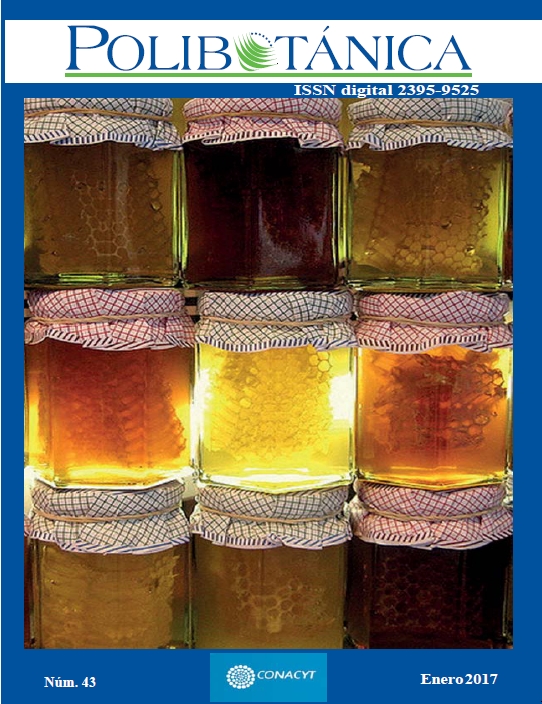STRUCTURAL CHARACTERIZATION OF MYRTLE SWAMP FOREST IN THE ARAUCANIA REGION, CHILE
DOI:
https://doi.org/10.18387/polibotanica.43.4Keywords:
myrtle, height, DBH, coverage.Abstract
Chile swamp forests have a wide and fragmented distribution (1 300 km approx.) and are dominated mainly by mirtaceas. They are associated with poorly drained soils, so their hydroperiods are temporary or permanent. The best-known aspect of these forests is the floristic-vegetation, although information on its structural composition is generally weak and nonexistent for the remnants of the La Araucanía region. The aim of this study was to characterize both vertical and horizontal structure of swampy forests that grow in the locality of Catrimalal, Labranza, Pumalal and Quepe in the central depression of La Araucanía region. In each locality a rectangular plot of 300 m2 was established, tree species present were recorded and basic dasometric parameters were measured. In order to determine differences between the studied localities an analysis of covariance (ANCOVA) and a Tukey test were carried out. The vertical structure consists of four species of trees: Blepharocalyx cruckshanksii (Hook. & Arn.) Nied, Drimys winteri J.R. Forst. & G. Forst., Luma chequen (Molina) A. Gray and Myrceugenia exsucca (DC.) O. Berg, whose general average of height and diameter at breast height (DBH) reach 11.8 m and 22.1 cm. respectively. The horizontal structure shows an average canopy cover of 87% and D. winteri as the species with the highest coverage of crown. Statistical analyzes indicate the presence of significant differences among localities, mainly in Quepe. Low average levels of canopy coverage and height compared to previous descriptions could suggest a human impact on these forests. The difference found in Quepe could be due to a shorter hydroperiod, since this phenomenon regulates among others, the structure of these ecosystems. Swamp forests are essential for the maintenance of groundwater, therefore actions for their protection and conservation are increasingly necessary.References
Benfield, S.; H. Guzman y J. Mair, 2005. Temporal mangrove dynamics in relation to coastal development in Pacific Panama. J. Environ. Manage., 76: 263-276.
Berger, U.; M. Adams, V. Grimm y H. Hildenbrandt, 2006. Modelling secondary succession of Neotropical mangroves: causes and consequences of growth reduction in pioneer species. Perspect. Plant Ecol., 7: 243-252.
Bradshaw, C.; N. Sodhi, K. Peh y B. Brook, 2007. Global evidence that deforestation amplifies flood risk and severity in the developing world. Glob. Change Biol., 13: 2379-2395.
Brooks, R., 2000. Annual and seasonal variation and the effects of hydroperiod on benthic macroinvertebrates of seasonal forest (‘‘vernal’’) ponds in central Massachusetts. Wetlands, 20: 707-715.
Charbonneau, N., y L. Fahrig, 2004. Influence of canopy cover and amount of open habitat in the surrounding landscape on proportion of alien plant species in forest sites. Ecoscience, 11: 278-281.
CONAMA, 2005. Estrategia nacional para la conservación y uso racional de los humedales en Chile. Comisión Nacional del Medio Ambiente. Santiago, Chile. 30 pp.
Correa-Araneda, F.; J. Urrutia y R. Figueroa, 2011. Estado del conocimiento y principales amenazas de los humedales boscosos de agua dulce de Chile. Rev. Chil. Hist. Nat., 84: 325-340.
Correa-Araneda, F.; J. Urrutia, Y. Soto-Mora, R. Figueroa y E. Hauenstein, 2012. Effects of the hydroperiod on the vegetative and community structure of freshwater forested wetlands, Chile. J. Freshwater Ecol., 27: 459-470.
Di Castri, F., y E. Hajek, 1976. Bioclimatología de Chile. Ediciones Universidad Católica de Chile. Santiago, Chile. 131 pp.
Donoso, C., 1993. Bosques templados de Chile y Argentina. Variación, estructura y dinámica. Editorial Universitaria. Santiago, Chile. 483 pp.
Fuentes, N.; P. Sánchez, A. Pauchard, J. Urrutia, L. Cavieres y A. Marticorena, 2014. Plantas invasoras del centro-sur de Chile: Una guía de campo. Laboratorio de Invasiones Biológicas, Universidad de Concepción. Concepción, Chile. 280 pp.
Gerritsen, J., y H. Greening, 1989. Marsh seed banks of the Okefenokee Swamp: effects of hydrologic regime and nutrients. Ecology, 70: 750-763.
González, M.; E. Hauenstein, F. Peña-Cortés, M. García y O. Urrutia, 2003. Comentarios sobre bosques pantanosos, humedales importantes del centro-sur de Chile. Gestión Ambiental, 9: 3-13.
Hauenstein, E.; M. González, F. Peña-Cortés y A. Muñoz-Pedreros, 2005. Diversidad vegetal en humedales costeros de la región de La Araucanía. En: Smith-Ramírez, C.; J. Armesto y C. Valdovinos (eds.), Historia diversidad y ecología de los bosques costeros de Chile, pp. 197-205. Editorial Universitaria. Santiago, Chile.
Hauenstein, E.; F. Peña-Cortés, C. Bertrán, J. Tapia, L. Vargas-Chacoff y O. Urrutia, 2014. Composición florística y evaluación de la degradación del bosque pantanoso costero de temu-pitra en la Región de La Araucanía, Chile. Gayana Bot., 71: 43-57.
Jaña-Prado, R.; J. Celis-Diez, A. Gutiérrez, C. Cornelius y J. Armesto, 2006. Diversidad en bosques fragmentados de Chiloé: ¿Son todos los fragmentos iguales? En: Grez, A.; J. Simonetti y R. Bustamante (eds.), Biodiversidad en ambientes fragmentados de Chile: Patrones y procesos a diferentes escalas, pp. 159-189. Editorial Universitaria. Santiago, Chile.
Latsague, M.; P. Sáez, E. Hauenstein y F. Peña-Cortés, 2010. Propagación vegetativa de Myrceugenia exsucca y Blepharocalyx cruckshanksii, especies dominantes del bosque pantanoso de la Depresión Intermedia de la región de La Araucanía, Chile. Bosque, 31: 247-251.
Lawes, M.; M. Griffiths y S. Boudreau, 2007. Colonial logging and recent subsistence harvesting affect the composition and physiognomy of a podocarp dominated Afrotemperate forest. Forest Ecol. Manag., 247: 48-60.
Meekins, J., y B. McCarthy, 2001. Effect of environmental variation on the invasive success of an nonindigenous forest herb. Ecol. Appl., 11: 1336-1348.
Meiners, S.; S. Pickett y M. Cadenasso, 2002. Exotic plant invasions over 40 years of old field successions: Community patterns and associations. Ecography, 25: 215-223.
Mitsch, W., y J. Gosselink, 2007. Wetlands. John Wiley & Sons. New York, U.S.A. 582 pp.
Obiri, J.; M. Lawes y M. Mukolwe, 2002. The dynamics and sustainable use of high-value tree species of the coastal Pondoland forests of the Eastern Cape Province, South Africa. Forest Ecol Manag., 166: 131-148.
Peralta, M., 1976. Uso, clasificación y conservación de suelos. Ediciones SAG. Santiago, Chile. 337 pp.
Pielou, E., 1975. Ecological diversity. Wiley Press. New York, U.S.A. 159 pp.
Promis, A.; G. Bergh, M. Serra y G. Cruz, 2013. Descripción de la flora vascular en el sotobosque de un bosque pantanoso y de una pradera antropogénica húmeda de junquillo en el valle del río Cisnes, región de Aysén. Gayana Bot., 70: 164-169.
Ramírez, C.; A. Ferriere y H. Figueroa, 1983. Estudio fitosociológico de los bosques pantanosos templados del sur de Chile. Rev. Chil. Hist. Nat. 56: 11-26.
Ramírez, C.; C. San Martín y J. San Martín, 1995. Estructura florística de los bosques pantanosos de Chile sur-central. En: Armesto, J.; C. Villagrán y M. Arroyo (eds.), Ecología de los bosques nativos de Chile, pp. 215-234. Editorial Universitaria. Santiago, Chile.
San Martín, C.; C. Ramírez y D. Contreras, 2006. Una nueva asociación boscosa pantanosa para Chile: Caldcluvio-Lumetun gayanae. Revista Geográfica de Valparaíso, 37: 77-87.
San Martín, J.; J. Solervicens, C. Ramírez, C. San Martín y M. Elgueta, 1992. Estudio fitosociológico de los bosques pantanosos de mirtáceas de la región del Maule, Chile. Ciencias Forestales, 8: 3-18.
San Martín, J.; A. Troncoso y C. Ramírez, 1988. Estudio fitosociológico de los bosques pantanosos nativos de la cordillera de la Costa en Chile central. Bosque, 9: 17-33.
San Martín, J.; A. Troncoso, C. Ramírez, C. San Martín y A. Duarte, 1990. Estudio florístico y vegetacional de los bosques pantanosos nativos de la cordillera costera entre los ríos Rapel y Mataquito, Chile central. Revista Geográfica de Chile Terra Australis, 33: 103-128.
Sokal, R., y J. Rohlf, 1981. Biometry: The principles and practice of statistics in biological research. W. H. Freeman and Company. San Francisco, U.S.A. 859 pp.
Steubing, L.; R. Godoy y M. Alberdi, 2002. Métodos de ecología vegetal. Editorial Universitaria. Santiago, Chile. 345 pp.
Villa-Martínez, R., y C. Villagrán, 1997. Historia de la vegetación de los bosques pantanosos de la costa de Chile central durante el Holoceno medio y tardío. Rev. Chil. Hist. Nat., 70: 391-401.
Walters, B., 2005. Ecological effects of small-scale cutting of Philippine mangrove forests. Forest Ecol. Manag., 206: 331-348.
Weinberger, P.; M. Romero y M. Oliva, 1973. Untersuchungen über die Dürreresistenz patagonischer immergrüner Gehölze. Vegetatio, 28: 75-98.
Downloads
Published
Issue
Section
License

Polibotánica by Departamento de Botánica de la Escuela Nacional de Ciencias Biológicas del Instituto Politécnico Nacional se distribuye bajo una Licencia Creative Commons Atribución-NoComercial-CompartirIgual 4.0 Internacional.




















